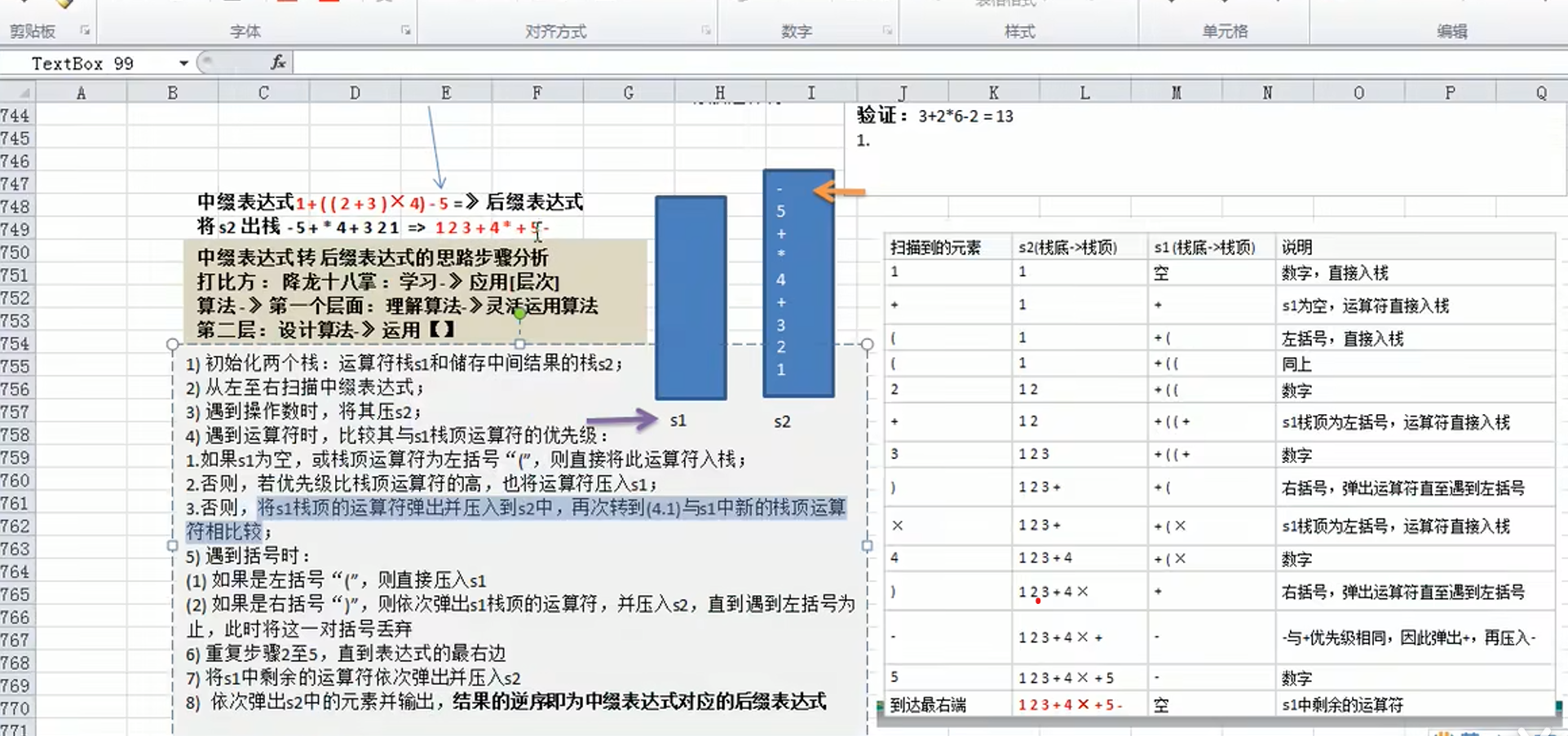
- 代码实现
import java.util.ArrayList;
import java.util.List;
import java.util.Stack;
public class text1 {
public static void main(String[] args) {
//先定义一个逆波兰表达式,为了方便,用空格分隔开
String s = "3 4 + 5 * 6 -";
//思路:先将3 4 + 5 * 6 -放到一个ArrayList的集合中去
//将ArrayList传进一个方法,遍历ArrayList配合栈完成计算
List<String> List = getList(s);
System.out.println(List);
int res = calculate(List);
System.out.println("计算结果为" + res);
//完成中缀表达式转后缀表达式
//放到一个集合中去
String s1 = "1+((2+3)*4)-5";
List<String> ls = change(s1);
System.out.println("中缀表达式为"+ls);
List<String> parse = parse(ls);
System.out.println("后缀表达式为"+parse);
int ress=calculate(parse);
System.out.println(ress);
}
//先定义一个逆波兰表达式,先将3 4 + 5 * 6 -放到一个ArrayList的集合中去
public static List<String> getList(String s) {
//将s分割
String[] split = s.split(" ");
List<String> list = new ArrayList<String>();
for (String ele : split) {
list.add(ele);
}
return list;
}
//计算
public static int calculate(List<String> list) {
//创建栈
Stack<String> stack = new Stack<>();
//遍历list
for (String item : list) {
if (item.matches("\\d+")) {
stack.push(item);
} else {
//pop出两个数和一个符号进行运算
int num1 = Integer.parseInt(stack.pop());
int num2 = Integer.parseInt(stack.pop());
int res = 0;
if (item.equals("+")) {
res = num1 + num2;
} else if (item.equals("-")) {
res = num2 - num1;
} else if (item.equals("*")) {
res = num1 * num2;
} else if (item.equals("/")) {
res = num2 / num1;
} else {
throw new RuntimeException("运算符有误");
}
stack.push("" + res);
}
}
//返回栈的最后一个结果
return Integer.parseInt(stack.pop());
}
//转化
public static List<String> change(String s) {
//创建一个空的集合去接收
List<String> list = new ArrayList<String>();
int i = 0;//指针
String str;//对多位数的拼接
char c;//遍历到每一个字符,就放入c
//如果c是一个非数字,就转入到list
//0【48】-9【57】对应的码为
do {
if ((c = s.charAt(i)) < 48 || (c = s.charAt(i)) > 57) {
list.add("" + c);
i++;
} else {
//如果是数字,需要考虑多位数
str = "";
while (i < s.length() && (c = s.charAt(i)) >= 48 && (c = s.charAt(i)) <= 57) {
str += c;
i++;
}
list.add(str);
}
} while (i < s.length());
return list;
}
//中缀表达式转后缀表达式
public static List<String> parse(List<String> sw){
//符号栈
Stack<String> stack = new Stack<>();
//数栈用集合表示
List<String> list = new ArrayList<String>();
for (String item:sw){
//如果是一个数
if (item.matches("\\d+")){
list.add(item);
}else if (item.equals("(")){
stack.push(item);
}else if (item.equals(")")){
//依次将stack中的符号弹到list中,直到遇到左括号
while (!stack.peek().equals("(")){
list.add(stack.pop());
}
stack.pop();//将"(“弹出栈,这个十分重要
}else {
//比较优先级问题
while (stack.size()!=0&&opertion .value(stack.peek())>=opertion.value(item)){
list.add(stack.pop());
}
//将运算符压入栈
stack.push(item);
}
}
//将剩余的运算符压入list
while (stack.size()!=0){
list.add(stack.pop());
}
//不需要逆向输出,应为用的是list
return list;
}
}
//编写一个类来比较运算符的优先级
class opertion{
private static int add=1;
private static int sub=1;
private static int div=2;
private static int mlp=2;
public static int value(String oper){
int res=0;
switch (oper){
case "+":
res= add;
break;
case "-":
res= sub;
break;
case "*":
res= mlp;
break;
case "/":
res= div;
break;
default:
System.out.println("运算符错误");
break;
}
return res;
}
}
中缀表达式转后缀表达式
发布时间 2023-03-23 15:22:08作者: 为TT